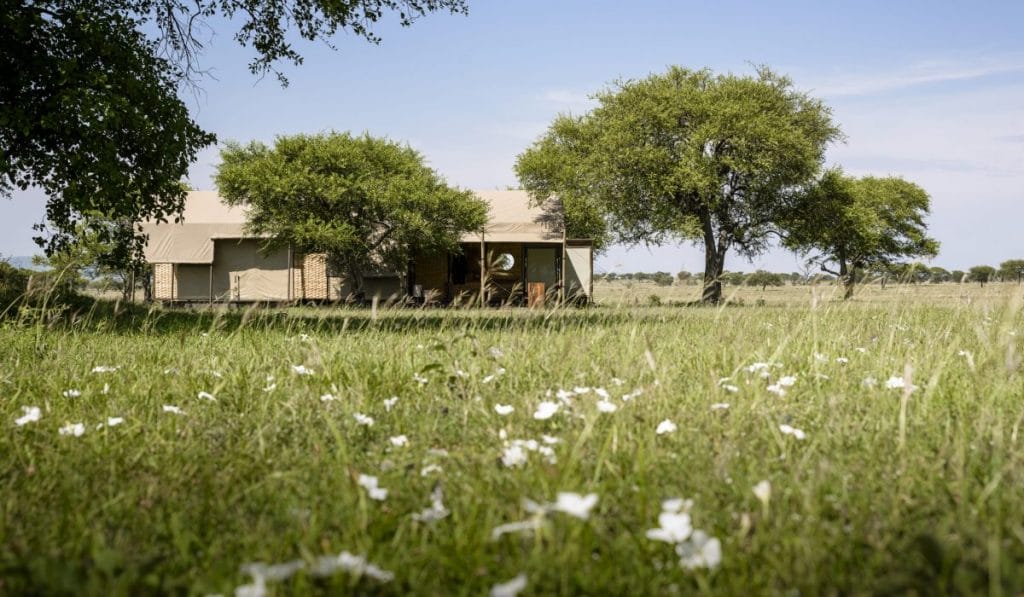When Singita tapped on architects Sally Tsiliyiannis from GAPP and Geordi da Sousa Costa from Cécile & Boyd to reimagine the African safari experience, it didn’t expect the spectre of Covid-19 to descend onto the globe.
In September 2020, the safari company finally unveiled the completely re-designed Sabora Tented Camp in Grumeti, Tanzania. We chatted with lead architect Tsiliyiannis on the challenges she faced during this project, the incredible amount of detail that went into the design, and how the tented camp embodies the ethos of sustainability in safari travel.

The bedroom in the Singita Sabora Tented Suite
What were the challenges you had to overcome during this project?
The project went on for over two years, from start to completion, including the inevitable delays that arose out of challenges related of Covid-19.
South Africa went into lockdown on 17 March 2020, less than two months after construction begun. So, apart from the initial site visit, we carried out all site supervision remotely. As architects, we were used to a very hands-on approach during construction, so this was a new challenge for us. Fortunately, the construction team was highly competent.
Although we came up with the design concept rather quickly, the stakeholders had a lot of doubt. They had a lot of nostalgia with the design of the old Sabora. We had to come up with many alternatives. However, they finally chose our initial forward-looking design after we completed the full-scale mock-up of a guest tent.
Tell us more about the design.
Being an ‘African’ firm working in Africa, we take pride in being contextually sensitive. We always draw on local references to ensure that the designs are a genuine reflection of the place.
For Sabora Tented Camp, we stuck to the basic principles of traditional safari tent design, avoiding more recent popular trends like tensile roof structures. After the recent restrictions placed on global travel, this simplified, less-is-more approach has proven to be in line with what the traveller is looking for – being re-energised and rebalanced through the simple pleasure of being immersed in nature.
We cut back the canvas roofs to allow natural light to flood into the interior. It also expanded the upward view, capturing the vastness of the African sky.

Lead architect Sally Tsilliyiannis
Weaving has also been an integral part of African culture for thousands of years. The local woven mats and baskets inspired us while creating the distinctly African tent architecture. The textured thick plywood strips on the doors, screens, ceilings and wall panels also create highly expressive surfaces when light hits them.
Together, these two elements infuse the spaces with a soft, golden glow that is so distinctive to the Serengeti.
Tell us more about the sustainability and environmental concepts, ideas and techniques put into place.
In tropical climates, it is imperative that the architecture has low-energy consumption and includes passive design features to regulate environmental conditions, while using responsibly sourced materials that is appropriate to the place and easily maintained or replaceable.
The camp is an off-the-grid design that embraces the One Planet Living sustainability framework adopted by Singita in 2013. This framework aims to achieve sustainability in environmental, economic and social terms. From the start, we employed simple passive design solutions, drawn from traditional tent design technology, to reduce the demand on the solar grid system and the impact on the environment.
Solar heaters beside each tent generate warm water and smaller sized baths prevent excessive waste of water. We also reduced exterior lighting to the absolute minimum, allowing guests to feel the thrill of the darkness and experience the magnificence of the African night sky.

A cheetah in the wild, captured near the Sabora Tented Camp
Sustainability is an oft-used buzzword now. How does Singita approach it?
Singita has sustainability goals that it wants to achieve by 2025, some of which include 50% of fresh produce being bought within a 100km radius and off-grid lodges to be 80% powered by on-site renewable energy.
An in-house sustainability specialist monitors building projects to ensure that Singita is on track to meet the long-term goals.
These days, sustainability is a prerequisite and not an option. It has become a natural part of how we think when creating new designs or repurposing existing lodges. It often limits our design choices and can be challenging. But, as the key driver behind the designs, there are always solutions and the outcomes are immensely satisfying.
This story first appeared in The Peak Singapore



